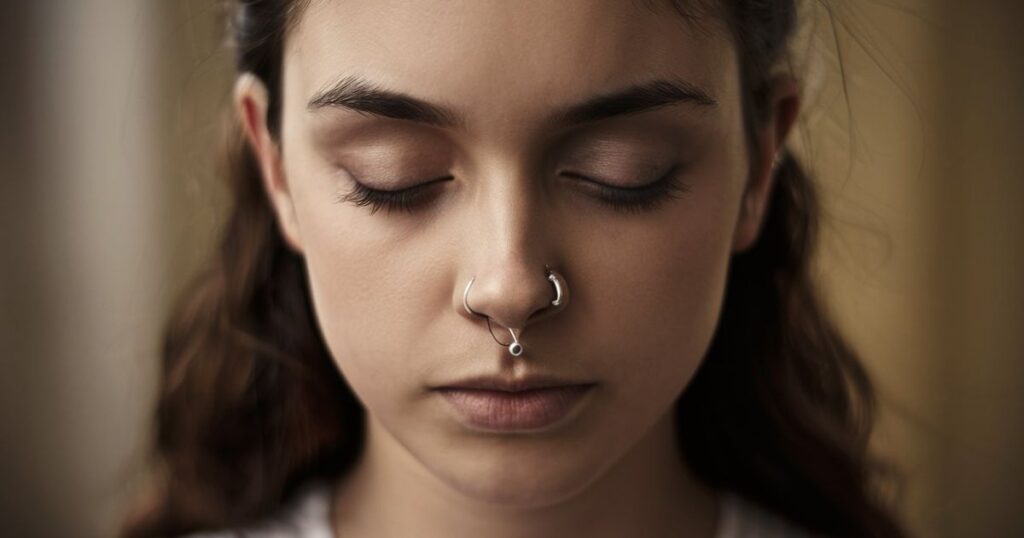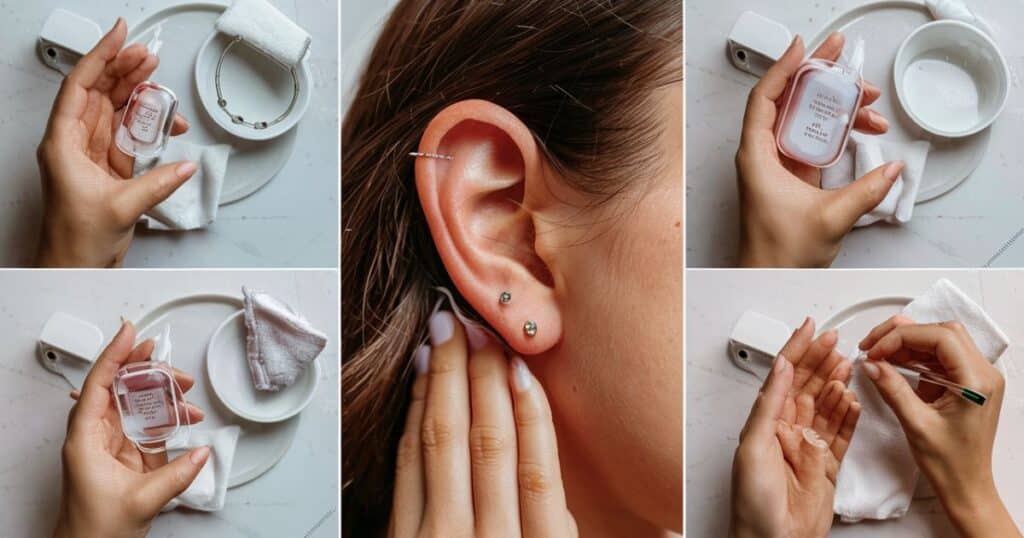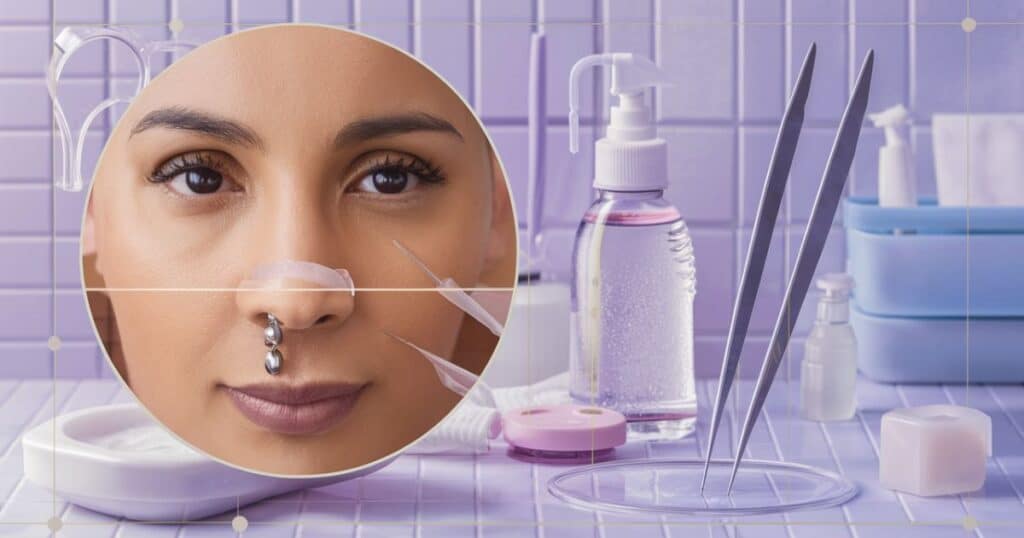Reopening a closed nose piercing at home means making a previously healed piercing hole in your nose open again. This can be done by gently inserting jewelry back into the piercing hole after cleaning it thoroughly. It’s important to be careful and gentle to avoid causing any damage or infection to the area.
Imagine a world where magic whispers through the leaves, where every step leads to a new adventure, and where heroes rise from the unlikeliest of places. Welcome to a realm where dreams and reality intertwine, beckoning you to join the quest of a lifetime.
Why Did My Nose Piercing Close Up?
Sometimes, if you don’t wear jewelry in your nose piercing for a while, the hole can close up. This happens because your body tries to heal the hole when there’s no jewelry in it. Your skin grows over the hole, making it closed. It’s like when you have a cut, and it heals over time.
Another reason your nose piercing might close up is if you get an infection. Infections can cause swelling and irritation around the piercing. When this happens, your body might try to heal the piercing by closing up the hole. It’s like your body’s way of protecting itself from the infection.

Sometimes, if you accidentally bump or snag your nose piercing, it can cause trauma to the area. This trauma can lead to the piercing closing up because your body wants to heal the damage. It’s important to be gentle with your piercing and take care of it to prevent it from closing up unexpectedly.
How To Use A Piercing Earring To Reopen Nose Piercing?
Nose piercings are small holes made in the skin of the nose where jewelry, like rings or studs, can be worn. Sometimes, these piercings can close up if the jewelry is not worn for a while or due to infection or trauma. Reopening a closed nose piercing involves gently inserting jewelry back into the piercing hole.
Here are some steps you can do easily:
- Clean the piercing area and your hands with mild soap and warm water.
- Use a piercing earring that is sterilized or cleaned with rubbing alcohol.
- Gently insert the earring into the closed piercing hole, applying slight pressure.
- If you encounter resistance, don’t force it; try using a lubricant like water-based gel or saline solution.
- Once the earring is inserted, rotate it gently to help prevent sticking.
- Clean the piercing area again and avoid touching it unnecessarily to prevent infection.
- Monitor the piercing for any signs of irritation or infection and consult a professional if needed.
If Your Piercing Hole Closes, Here’s What Dermatologists Say
If your piercing hole closes, dermatologists suggest that you avoid trying to force jewelry back into it. This could lead to irritation, infection, or further damage to the skin. Instead, they recommend seeking professional help from a dermatologist or a professional piercer to safely reopen the piercing.
Dermatologists also advise keeping the area clean and applying a warm compress to help soothe any irritation. It’s essential to follow their guidance and avoid self-piercing or using unsanitary tools, as this can increase the risk of complications. Consulting a dermatologist ensures proper care and reduces the chance of infection or scarring.
How Long Does It Take for a Piercing to Close?
The time it takes for a piercing to close depends on various factors such as the location of the piercing, how long you’ve had it, and individual differences in healing. Generally, smaller piercings like earlobes may start to close within a few hours to days if jewelry is removed.

However, larger or more established piercings, such as cartilage or nose piercings, may take weeks or even months to close fully. It’s essential to consult with a professional piercer or dermatologist for personalized advice based on your specific situation.
Recommended Post: When Can A Nursing Home Take Your Social Security Check?
Can I Re-Open the Hole?
Yes, in many cases, you can reopen a closed piercing hole. However, it’s essential to proceed with caution and avoid causing further damage or infection. Gentle techniques such as slowly inserting sterilized jewelry back into the piercing hole after cleaning the area can help reopen it. If you encounter difficulties or signs of infection, it’s advisable to seek assistance from a professional piercer or dermatologist for safe and effective reopening.
How to Prevent a Hole Closing?
Step-by-step guide on how to prevent a piercing hole from closing:
Regularly Wear Jewelry: Ensure that you consistently wear jewelry in your piercing to keep the hole open. If you need to remove the jewelry temporarily, try to do so for the shortest time possible.
Avoid Prolonged Jewelry Removal: Minimize the duration your piercing remains without jewelry, as extended periods without jewelry increase the risk of closure.
Keep the Area Clean: Clean your piercing regularly with a mild saline solution or an antiseptic solution recommended by a professional piercer or dermatologist. This helps to prevent infections that could lead to closure.
Rotate Jewelry: Occasionally rotate or move the jewelry in your piercing gently to prevent it from sticking to the skin and to promote healthy healing.
Avoid Trauma: Be mindful of activities that could cause trauma to the piercing area, such as excessive pulling, snagging, or pressure. Protect your piercing during sports or activities where it could be bumped or caught.
Follow Aftercare Instructions: Adhere to any aftercare instructions provided by your piercer or dermatologist diligently. This may include avoiding certain products or practices that could irritate or harm the piercing.
Regular Check-ups: Schedule regular check-ups with your piercer or dermatologist to ensure the health of your piercing. They can assess the piercing’s condition and guide how to maintain it properly.
Can I Re-Pierce the Hole?
Yes, it is possible to re-pierce a closed hole from a previous piercing. However, it’s crucial to approach re-piercing with caution and seek assistance from a professional piercer or dermatologist. They can assess the area, guide proper healing, and ensure the procedure is performed safely to minimize the risk of complications such as infection or scarring.
How to Care for Your Piercing?
Caring for your piercing is important to prevent infection and promote healing. Start by cleaning the piercing twice a day using a saline solution or a gentle cleanser recommended by your piercer. Avoid touching the piercing unnecessarily to prevent introducing bacteria.

Avoid swimming in pools, lakes, or oceans until the piercing is fully healed to prevent infections. Be gentle when handling the piercing, and avoid changing or removing the jewelry too soon, as this can disrupt the healing process. Follow your piercer’s aftercare instructions closely for the best results.
Re-Opening A Closed Nose Piercing Hole
Re-opening a closed nose-piercing hole requires patience and caution. Start by cleaning the area around the piercing with mild soap and warm water to ensure it’s free from dirt and bacteria.
Next, gently try to insert sterilized jewelry, such as a piercing earring, into the closed hole. If you encounter resistance, do not force it, as this could cause further damage or infection. Instead, consider using a lubricant like water-based gel or saline solution to help ease insertion.
After successfully re-opening the piercing, continue to keep the area clean and avoid unnecessary touching or rotating of the jewelry. Monitor the piercing for any signs of irritation or infection, and seek professional help if needed. With proper care and attention, you can safely re-open a closed nose-piercing hole.
Read Also This Post: What Kills Fire Ants Home Remedies?
Wash Your Hands
Washing your hands is a simple yet crucial instruction for maintaining cleanliness and preventing the spread of germs. To follow this guidance, thoroughly wet your hands with water, apply soap, and scrub all surfaces of your hands, including between your fingers and under your nails, for at least 20 seconds.
Rinse your hands well under clean, running water, and dry them using a clean towel or air dryer. This routine should be practiced regularly, especially before eating, after using the restroom, or when handling food to keep yourself and others healthy.
Keep it Clean
Keep it clean is a straightforward reminder to maintain cleanliness in your surroundings or about a specific object or area. This entails regularly removing dirt, dust, and debris, as well as sanitizing surfaces to prevent the spread of germs. Whether it’s your living space, workspace, or personal belongings, ensuring cleanliness contributes to a healthier environment and reduces the risk of illness or contamination.
Remembering to tidy up regularly and adopt hygienic practices helps promote overall well-being and a pleasant living or working environment for everyone.
Cleaning the Piercing
Cleaning the piercing involves gently washing the pierced area with a saline solution or a mild soap and warm water. It’s essential to clean the jewelry carefully, removing any debris or crust that may have accumulated. Avoid using harsh chemicals or alcohol-based products, as they can irritate the skin.
Regular cleaning helps prevent infection and promotes healing, especially during the initial stages after getting pierced. Be consistent with your cleaning routine and follow any specific aftercare instructions provided by your piercer for optimal results.
Cleaning the Jewelry
Cleaning the jewelry worn in your piercing is important to keep it free from dirt and germs. You can clean your jewelry by soaking it in a saline solution or gently scrubbing it with mild soap and water. Be sure to rinse the jewelry thoroughly afterward to remove any soap residue. Regular cleaning helps prevent infections and keeps your piercing healthy.
Inserting the Jewelry
Inserting the jewelry into your piercing is a delicate process that requires cleanliness and care. Before insertion, it’s crucial to wash your hands thoroughly with soap and water to prevent introducing any germs. When inserting the jewelry, gently guide it into the piercing hole, being mindful not to force it or cause any discomfort.
If you encounter resistance, it’s best to stop and seek assistance from a professional piercer to avoid any potential damage to the piercing. Remember to handle the jewelry with clean hands and avoid touching the pierced area unnecessarily to minimize the risk of infection.
Removal Caused by Infection
Removal caused by infection refers to the situation where jewelry in a piercing is taken out due to the presence of an infection. Infections can occur when bacteria enter the piercing site, leading to symptoms such as redness, swelling, pain, and discharge.
In severe cases, the body may attempt to heal the infection by closing the piercing hole, resulting in the removal of the jewelry. It’s essential to address infections promptly by seeking medical attention to prevent further complications and facilitate healing.
Healing Time for a Nose Piercing
Initial Healing: The initial healing period for a nose piercing typically lasts around 6 to 8 weeks. During this time, it’s common to experience some swelling, redness, and tenderness around the piercing site.
Complete Healing: While the initial healing phase lasts a few weeks, complete healing of a nose piercing can take several months to a year. The exact duration varies depending on individual factors such as healing ability, aftercare practices, and the type of piercing.
Signs of Healing: As the piercing heals, you may notice a decrease in swelling and redness, and the piercing site may feel less tender to the touch. Additionally, any discharge or crust around the piercing should gradually decrease.
Aftercare Importance: Proper aftercare is crucial for promoting healing and reducing the risk of infection or complications. This includes cleaning the piercing daily with a saline solution or gentle cleanser, avoiding touching or rotating the jewelry unnecessarily, and avoiding activities that could irritate the piercing.
Consultation: If you have concerns about the healing process or experience prolonged discomfort or signs of infection, it’s essential to consult a professional piercer or healthcare provider for guidance and assistance.
Individual Variations: It’s important to note that healing times can vary significantly from person to person. Factors such as age, overall health, and lifestyle habits can influence how quickly a nose piercing heals. Patience and proper care are key to ensuring a successful healing process.
Frequently asked questions
Can I reopen my nose piercing myself?
It’s not recommended to reopen your nose piercing yourself as it can lead to complications like infection or scarring. Seek professional help from a piercer or dermatologist instead.
What to do if I can’t get my nose piercing back in?
If you’re having trouble reinserting your nose piercing, avoid forcing it. Clean the area gently and consider seeking assistance from a professional piercer who can help reopen the piercing safely.
What to do if nose piercing closes?
If your nose piercing closes, don’t panic. You can seek advice from a professional piercer or dermatologist on how to safely reopen it. Avoid attempting to reopen it yourself to prevent further damage.
How do you open a closed nose ring?
Opening a closed nose ring should be done carefully and preferably by a professional piercer. They can use specialized tools and techniques to gently reopen the piercing without causing harm. Avoid attempting to force the jewelry back in yourself.
How long does it take for a closed nose piercing to reopen?
The time it takes for a closed nose piercing to reopen varies depending on factors such as the duration of the closure, individual healing abilities, and proper care. Seeking guidance from a professional piercer or dermatologist can provide personalized advice on reopening timeframes and techniques.
Conclusion
Reopening a closed nose piercing at home requires caution and gentle care. It’s essential to clean the area thoroughly and avoid forcing jewelry back into the piercing. Seek professional assistance if you encounter difficulties or signs of infection to ensure safe and effective reopening. With proper care and attention, you can successfully reopen your nose piercing and maintain its health.

Warner Clips is an expert writer with 4 years of experience crafting engaging content on Home topics. My expertise ranges from creating cozy environments to tackling Home Improvement projects. Find my work in publications like Huffington Post and Reader’s Digest.







